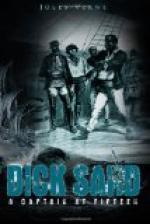Meanwhile, each day, generally in the afternoon, Dick Sand neared one bank or the other, moored the boat, disembarked, and explored the shore for a short distance.
In fact, it was necessary to renew their daily food. Now, in this country, barren of all cultivation, they could not depend upon the tapioca, the sorgho, the maize, and the fruits, which formed the vegetable food of the native tribes. These plants only grew in a wild state, and were not eatable. Dick Sand was thus forced to hunt, although the firing of his gun might bring about an unpleasant meeting.
They made a fire by rubbing a little stick against a piece of the wild fig-tree, native fashion, or even simiesque style, for it is affirmed that certain of the gorillas procure a fire by this means. Then, for several days, they cooked a little elk or antelope flesh. During the 4th of July Dick Sand succeeded in killing, with a single ball, a “pokou,” which gave them a good supply of venison. This animal, was five feet long; it had long horns provided with rings, a yellowish red skin, dotted with brilliant spots, and white on the stomach; and the flesh was found to be excellent.
It followed then, taking into account these almost daily landings and the hours of repose that were necessary at night, that the distance on the 8th of July could hot be estimated as more than one hundred miles. This was considerable, however, and already Dick Sand asked himself where this interminable river ended. Its course absorbed some small tributaries and did not sensibly enlarge. As for the general direction, after having been north for a long time, it took a bend toward the northwest.
However, this river furnished its share of food. Long lianes, armed with thorns, which served as fishhooks, caught several of those delicately-flavored “sandjikas”, which, once smoked, are easily carried in this region; black “usakas” were also caught, and some “mormdes,” with large heads, the genciva of which have teeth like the hairs of a brush, and some little “dagalas,” the friends of running waters, belonging to the clupe species, and resembling the whitebait of the Thames.
During the 9th of July, Dick Sand had to give proof of extreme coolness. He was alone on the shore, carrying off a “caama,” the horns of which showed above the thicket. He had just shot it, and now there bounded, thirty feet off, a formidable hunter, that no doubt came to claim its prey, and was not in a humor to give it up. It was a lion of great height, one of those which the natives call “karamos,” and not one of the kind without a mane, named “lion of the Nyassi.” This one measured five feet in height—a formidable beast. With one bound the lion had fallen on the “caama,” which Dick Sand’s ball had just thrown to the ground, and, still full of life, it shook and cried under the paw of the powerful animal.
Dick Sand was disarmed, not having had time to slide a second cartridge into his gun.




